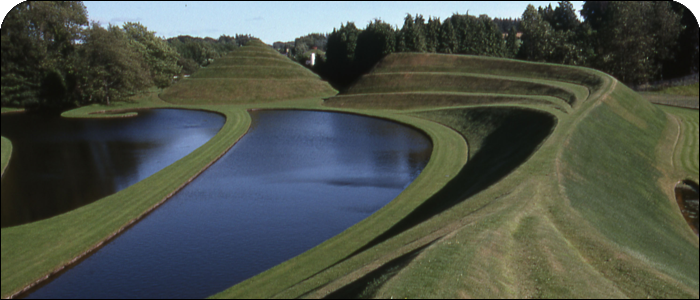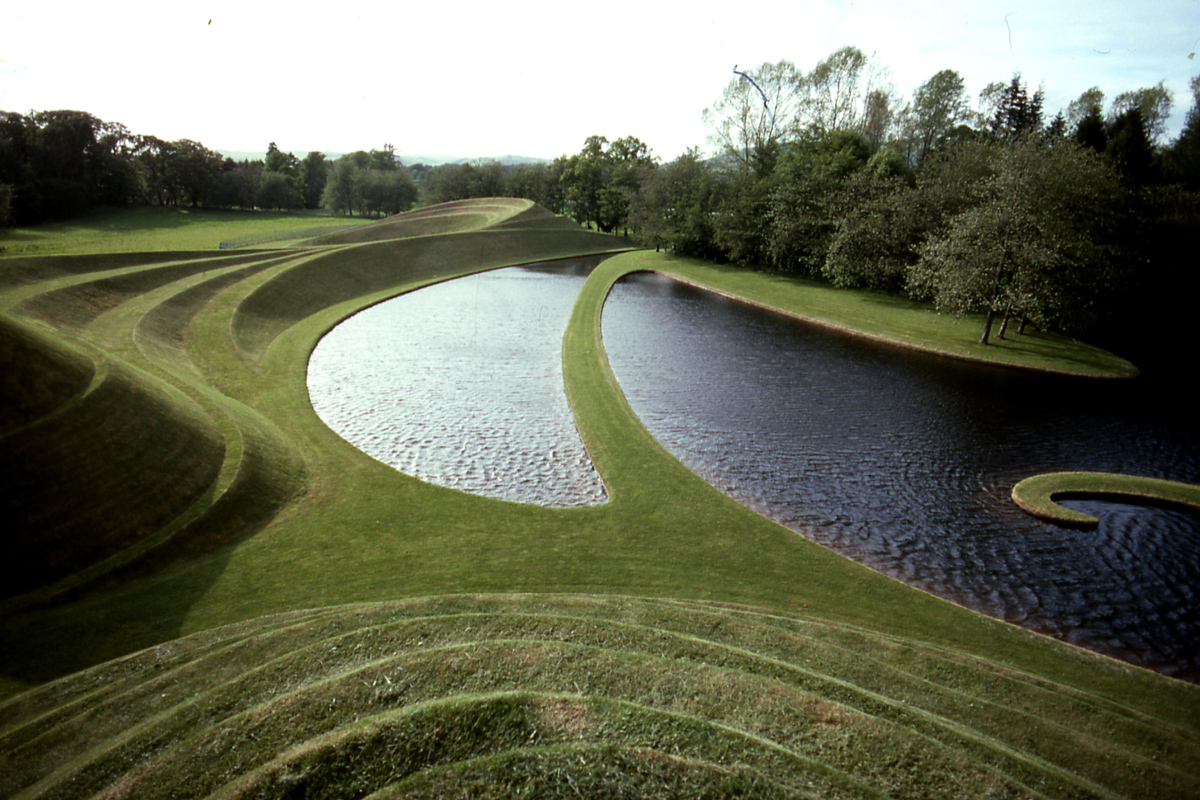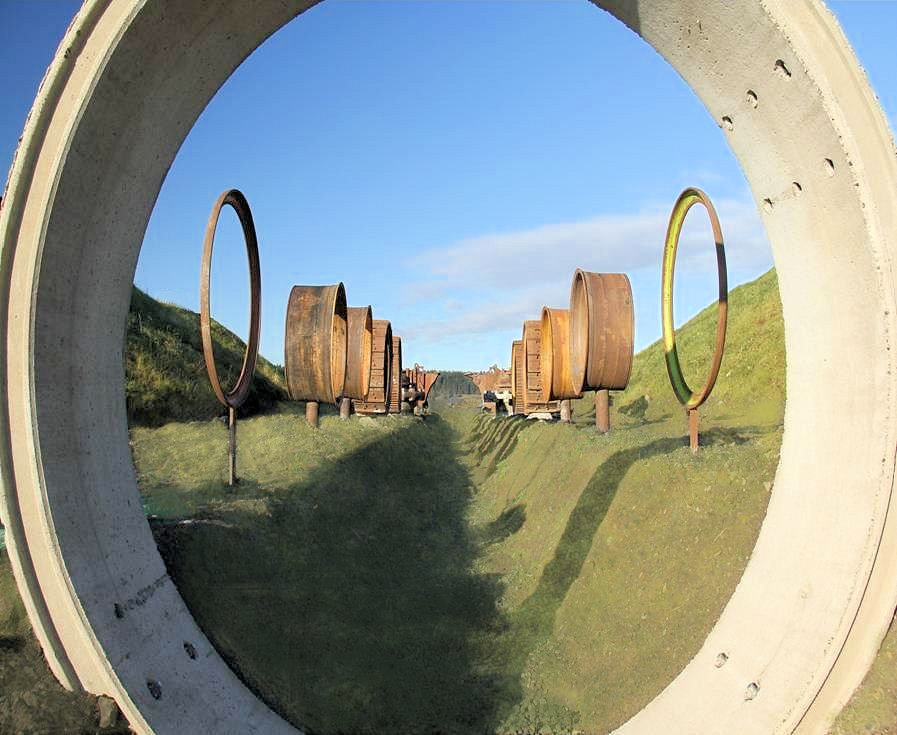
CHARLES JENCKS
FIFE EARTH/SCOTTISH WORLD PROJECT
Being a freelance writer, broadcaster and producer in the field of Scottish culture can at times be frustrating and fraught, but the compensations can be immense when you see the effect of your work on the people you come from.Now and again, though an amazing project comes along which makes up for all the downsides, as it could leave a lasting inspirational legacy for Scotland and her contribution world wide. For me it began with an e mail received in April 2010, which contained the following:
Dear Billy Kay
I am an admirer of your book on The Scottish World, and I was hoping you would join a team that is dedicated to constructing a series of large earthworks based on how the Scots settled in so many parts of the world.
It is a project I am involved with of Scottish Coal, near the town of Kelty on the M90. We are working on a series of large mounds that represent how the Scots went around the world over several hundred years and left their mark. Books by Arthur Herman and Neal Ascherson have influenced me in this project, but particularly yours, and have formed the basis of a mappa mundi showing where the Scots settled and the place names changed to reflect this.
Because of your writing I am hoping you will join a team to help inspire and help guide our future depiction of this landscape.
We all would value your advice and support in this project.
Best wishes
Charles Jencks
 Please click on the above image to enlarge
Please click on the above image to enlarge
I was already an admirer of Charles Jenck's work at the Gallery of Modern Art in Edinburgh, in fact when I went to exhibitions there I sometimes feel slightly guilty to admit that I felt more attracted to his sculpted garden outside the gallery than much of the art within! Seeing however, examples of his phenomenal work at Portrack and elsewhere, I am convinced that the Fife Earth Project has the potential to become one of THE iconic Scottish landmarks which will define the nation and its role in the world and restore a massive, blighted, opencast mining landscape to something magical and memorable. Through the help and support of Theo Phillip and Colin Ortlepp of Scottish Coal, I am now working with Charles to see which particular aspects of the Scottish World deserve to be celebrated on the site of the great Fife Earth/Scottish World Project.
Here is a taste of the promotional material for the Project:
The Scottish World - The Fife Earth Project
From the scarred landscape of the site of an open cast mine a striking, iconic, sculpted landscape is emerging which will celebrate the extraordinary influence the Scots have had on communities and cultures on every continent. Scottish Coal has commissioned internationally renowned designer Charles Jencks to create a place which has the potential to become one of the major cultural and tourist destinations in the country. He asked the award winning author and broadcaster Billy Kay to act as consultant on this story of the Scottish World, where well over 25 million people consider themselves to be Scots. Even more remarkable is the fact that millions more belong to cultures which have been profoundly influenced by Scots teachers, missionaries, merchants, engineers, pedlars, writers, soldiers, diplomats, sportsmen and philosophers!
Here, four enormous mounds, representing the four corners of the earth where Scots have settled, will use land art to tell this phenomenal story. A loch in the shape of Scotland will orient visitors as they walk around the extraordinary landscape discovering, for example, a new view of the Enlightenment and other key Scottish contributions to global history.
 The sculpted landscape taking shape the European Mound. (work in progress)
The sculpted landscape taking shape the European Mound. (work in progress)
On these landforms we will expand people's view by marking unsuspected and fascinating truths: the fact of the wealthy Scottish merchant community in Poland and Prussia and the thousands of pedlars and mercenaries who settled there; of national geniuses of Scots descent, such as Lermontov in Russia and Grieg in Norway; of an American Civil War blamed on Sir Walter Scott by Mark Twain; of inspirational missionaries in Calabar and Budapest; of Scotch Professors establishing football in strongholds like Barcelona and Buenos Aires; of pioneers like Sandeman and Cockburn and the Scottish roots of some of the great wines of Europe; and of our amazing involvement in liberation movements in Malawi, Chile, Peru, Greece, Corsica and India.
On visiting the great garden of the Scottish World you will experience a stunning landscape of terraced mounds, futuristic pyramids and dramatic lochs which together depict a mappa mundi a map of the world you can walk and explore to discover the art work and sculpture, the cairns and carving, the words and poetry that reflect the enormous contribution the Scots have made to the world we live in today.
 The Avenue of Doubles on the European Mound (work in progress)
The Avenue of Doubles on the European Mound (work in progress)
Some quotes from Kay's book, The Scottish World, which give an impression of the content of the Garden and the potential for educational back up at a Visitors Centre and Website.
Soldiers of Fortune: The Electress of Hanover on her commander of troop, Andrew Melville.
Soldier of Misfortune, I call him for cannon shot has taken away his chest which is supported by an iron contraption...I believe the Scots are not descended from Adam but from the serpent...you cut them up into 16 pieces and they join together again!"
Merchants :The wealthy Scots merchant community in 17th Century Poland described here by our first travel writer Sir William Lithgow
Here (at Lublin) I found abundance of gallant rich merchants, my countreymen who were all very kind to me, and so were they by the way in every place where I came, the conclusion being ever sealed with deep draughts and 'God be with you!
Prussian Mentality:In the History of the District of Deutsch Krone written at the turn of the 20th century, F. Schmidt described the legacy of the earlier Scottish migration in the character of the people:
The increase in strength and industrial capacity which this Scottish admixture instilled into the German was of the very highest importance, and it can scarcely be doubted that the peculiar compound of stubbornness and shrewdness which characterises the inhabitants of the small towns of eastern Prussia has its roots in the natural disposition of the Scot.
Budapest:Jane Haining, the Scotswoman who died in Auschwitz taught at the Scottish Mission school there. A Jewish pupil, Szuzsanna Paisz looks back:
I think that the Scots school was the only place at the beginning of the 1940's in Hungary where a Jewish child could live and had not to be ashamed.
Folklore:A saying used by mothers in Prussia and Poland to frighten bairns who feared being taken away by Scots pedlars.
Warte bis der Schotte kommt! Wait till the Scot comes an gets ye!
The images of the Garden at Portrack in Dumfriesshire, are from the book The Garden of Cosmic Speculation by Charles Jencks.Source: Charles Jencks
The two early images of the developing Fife Earth Project are from Theo Phillip of Scottish Coal.

